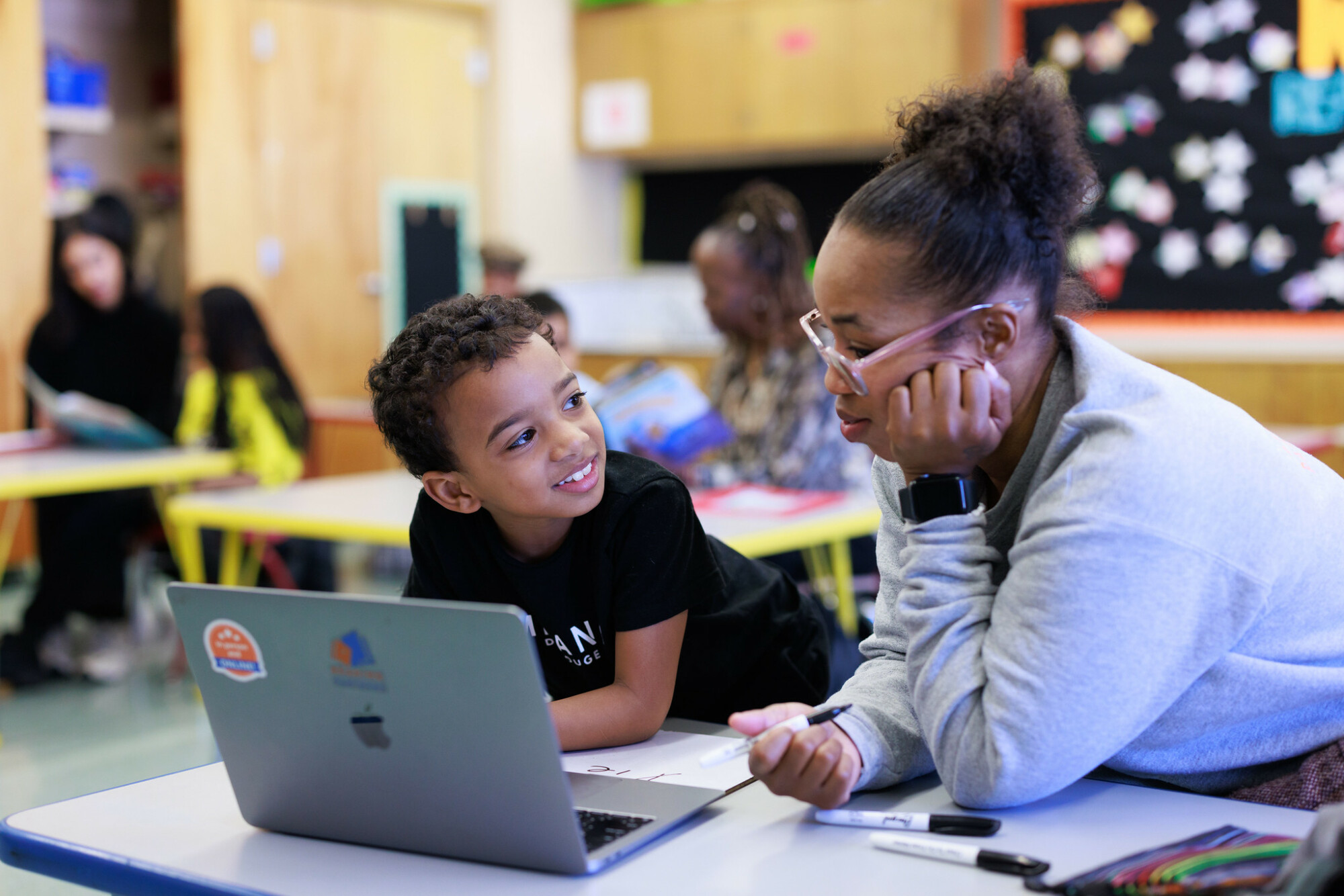
Iteration and innovation: How we approach new projects at Reading Partners
May 5, 2025
Manager of partnerships
We started this series on innovation at Reading Partners last fall by pulling back the curtain on Reading Partners’ pilot process and introducing the pilots we’re running this program year—we’re excited to share what we find after we analyze this year’s data in the coming months!
In the meantime, we’re zooming out a bit to consider our approach to innovation more broadly. We’ll also share some insights from one of our biggest, ongoing innovations to date: Reading Partners Connects, our digital tutoring platform. Joining us on this journey is Dean Elson, our chief knowledge officer, and Yaseer Khanani, our director of product and design.
Nonprofit organizations are often challenged by competing priorities. One such dilemma can be framed this way:
- Organizations should do work that has been demonstrated to yield results in accomplishing their mission.
- Organizations should continue to adapt to the changing needs of the communities where they serve.
How does Reading Partners approach this dilemma? Read on to find out!

Approaching innovation
First, we have some highlights from a conversation with Dean about the importance of learning, innovation, and change management, particularly in the context of Reading Partners’ mission.
“Keeping students at the center, we begin with the end in mind, with the change we want to see: where do we want to be, and what can we learn?” -Dean
The world keeps changing: new policies emerge, technology advances, and education systems evolve. On top of that, we have to stay up to date on the latest from the science of reading and from real-world implementation in schools. As we learn more about how best to teach reading, we also learn to engage students in new and different ways, because their worlds are changing too. We have to innovate and adapt our programs to respond to what’s happening in schools, in communities, and with families.
An innovative idea can come from anyone: staff and service members, volunteers, partners, donors, or other community members. We decide which innovations to prioritize based on how well they might do one of two things:
- Deepen the impact on students’ learning, or
- Expand our reach to more families and communities.
If an idea has good potential, we ask a lot of questions:
- Can we implement this idea across all of our regions?
- Can we bring this idea beyond school buildings? Is it adaptable to different contexts?
- Does this idea meet our mission for educational opportunity for all?
- What’s the potential impact on our organization’s staff and service members, and our overall capacity?
- What’s the actual cost?
The deeper we go in understanding the idea, the better we can see how it may or may not lead to where we’re going next.
If we decide to move the idea forward, the next step is to do a pilot. We collect quantitative data on student learning. We also collect qualitative data evaluating the context in which we have implemented the innovation. We have to understand the results in the context of implementation. What specifically leads to success? What are the greatest challenges?
These answers help us to understand what went right if we reached our quantitative goals, or what went wrong if we fell short. Sometimes, we make tweaks to our implementation to see if those factors lead to greater success. Once the innovation is successful, we scale it.

Change management
Inherent in innovation is change management. A major challenge here is that not everyone comes to believe in the change at the same time. Some skeptics will be reached by involving them in the planning process—that’s why pilots are helpful. Even if they aren’t directly involved, they may have colleagues who they trust to participate in a pilot—if their peers endorse the change, they may be more willing to try it out themselves.
We have to find early adopters—people who are willing to try new things. Often, these are folks who can see that the status quo is not working and want to try something new. It can be difficult for folks in our reading centers to focus on program innovations in the midst of all the other noise. If we can involve a wide variety of team members in the planning, more folks are eager to participate.
Unfortunately, sometimes we see teams give up too early. Sometimes they tweak the pilot to the point where the data isn’t meaningful. Innovation goes downhill if it’s considered a side project, something that’s less important than the day-to-day work. Early adopters can mitigate this risk. They will stick to the plan and pay attention to the results so we can all learn from it.
Our people need to know that what we’re doing isn’t just innovation for innovation’s sake. They need to know the rationale—why are we making this change? We have to share the history and context. With hundreds of staff and service members and thousands of volunteers working in schools from coast to coast, effective communication at each stage of the process is critical. And we have to make sure we’re pacing the changes in a way that folks can manage.
Innovation is at the core of meeting students’ needs. We shouldn’t be doing the same thing year over year. We don’t necessarily need to be on the cutting edge, since that’s where things are still being tested. But it’s been said that a new finding coming out of research could take 10 years before it’s put into practice. We don’t want to wait that long!
Bottom line: What are the transformative bets that could scale up literacy services to students and families now?

Transformative bets
Reading Partners is not just a tutoring organization. We’re expanding the walls of the reading center. We do individualized tutoring really well, and want to keep evolving those programs. We also must think more broadly about how to serve more students and families, which will take us beyond tutoring in schools. There’s not just one type of measurable result that we’re looking for. There’s not just one type of individualized instruction that we’re providing. We need to create greater opportunity for students with new and different literacy supports and services, and that will come from innovation.
“When you have millions of K-5th grade students not yet reading on grade level because the systems and existing solutions are inadequately supporting them, why would you focus nearly all your time and energy on a program that so far has only ever served 11,300 students in a single year? Is that number of students impressive? Yes. And the need is so much bigger than that.” – Dean
Transforming Reading Partners Connects
Now, we’ll wrap up with some highlights from a conversation with Yaseer about change management with his work on transforming Reading Partners (RP) Connects.
So much of this work involves learning! In one case, the platform is growing continuously. We’re constantly updating things, so there’s always something new to learn. How does this new feature work in different situations? How does one change impact other platform features?
We’re also always learning about users. User needs continue to evolve—what they want now is different from what they wanted last year.
Simultaneously, we’re learning about the market—the people who aren’t users yet. What are these new potential partners looking for? With machine learning and the boom in AI, for example, there may be new solutions that we haven’t thought about yet.
With all that learning in mind, what has been a salient “lesson learned” from building and rolling out RP Connects 2.0?
Starting small and building up
One of the first issues was that the scope of our project was massive. As we dug in more and more, we learned we weren’t going to be able to build it all in the timeline. This made a stressful process—every couple of weeks, we had to decide what to deprioritize to make the timeline.
So if we had kept the scope small, just the foundational features we needed on a tight timeline, then we could build up from that. We tried to do a lot from the get-go, which caused a lot of stress and missed expectations.
“It’s like you’re cooking something new: maybe others have done it, but you haven’t, not with the tools you have and the time constraints. It’s not necessarily going to be the same as what others have done.” -Yaseer
So many things are unknown in software development when you’re building something new. We have to communicate changes as they occur.

Start by communicating the scope. Everyone may not agree about what needs to be prioritized, but if we’re saying yes to everything, we’ll have too big of a scope. So that means prioritizing and communicating why.
When things change, allow it to be a collaborative decision-making process. Instead of making the decisions for the team, make decisions with them. This requires carving out the time and capacity to answer the questions people have.
“It takes capacity to be transparent. Ultimately, more information can yield more empathy, building trust.”-Yaseer
Once the changes go live, the work isn’t finished. We have to create avenues for receiving user feedback. And we receive a lot of feedback! Processing it all means understanding three things:
- What does the user need?
- How is the need not being met currently?
- And what is the scale of the need—are some users, many users, or all users impacted?
Often, users will surface a solution, but the solution may or may not address the underlying issue. Gaining a better understanding of the origin of the issue may help us to come up with a solution that can help other users as well. Once this is clear, we can prioritize this piece of feedback based on our strategic goals.
Yaseer created a process to assign a product score to evaluate the user impact, the scale, and the technical impact required for each update.
While we can determine the scale and technical impact on our end, user impact can be harder to quantify. We have found a way to generate a score by distributing user surveys broadly, sharing survey results, and giving everyone an equal vote on what to prioritize. Analyzing all of this information allows us to make well-informed decisions about which innovations to prioritize and a general timeline, or roadmap, for their development.
We hope you’ve enjoyed this look behind the scenes of the innovation process at Reading Partners. Let us know what you think, and know that we always take your ideas and thoughts to heart as we all work together to help students become lifelong learners through the power of literacy!



